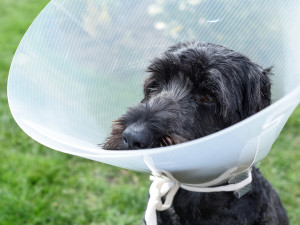How Much Does It Cost to Spay a Dog in the UK?
The lowdown on spaying costs in the UK
In this article:
What is spaying? How much does it cost to spay a dog? Cost factors Is spaying covered by pet insurance? How to save money on spaying Spaying FAQs
Bringing home a new puppy is beyond exciting, but let’s face it – it can be a bit of a wallet workout. Between the cost of food, bedding, toys and the casualties of a teething pup’s gnawing spree, it’s easy to feel the financial pinch. So, when the topic of spaying comes up, you might be wondering: how much does it cost to spay a puppy? And, more importantly, is it really necessary?
If you’re unsure what spaying or neutering involves or why it’s important, you’re not alone. There's a lot of conflicting advice out there, and pricing? It isn’t exactly a one-size-fits-all answer. Costs vary depending on factors such as your location, your dog’s size and breed, and any additional medical needs.
Main takeaways
Spaying involves removing a female dog’s ovaries and womb, while neutering refers to the removal of a male dog’s testicles. Both procedures prevent reproduction.
Costs vary depending on factors such as your dog’s size, breed and location.
In the UK, average prices start at £110 for neutering and £130 for spaying.
Financial support may be available through vet plans, council schemes or charities.
What is spaying?
Spaying is one of the most common procedures for dogs in the UK. According to the dog welfare charity Dogs Trust, around 60 percent of dogs in its long-running Generation Pup studyopens in new tab were neutered by the age of 15 months. That’s over half of pet parents in the study who’ve gone down this route and if you’ve landed on this article, you’re probably considering it too.
But before any surgery, you’ll naturally want to know what’s involved and happens to your beloved pet.
“Spaying refers to the surgical procedure for female dogs, which involves removing both the uterus and ovaries,” says Dr Kate McCrossan, a veterinary surgeon practising in Northern Ireland. “For male dogs, the procedure is called neutering or castration, and involves removing the testes. The goal of both operations is to remove the reproductive organs.”
Spaying vs neutering
“Spaying, also known as ovariohysterectomy, is a surgical procedure performed on a female dog under general anesthesia,” says Dr McCrossan. “We usually remove all reproductive organs – both ovaries, the uterus, and the cervix. Some vets only remove the ovaries as it is less invasive, however, not all dogs are candidates for this procedure.”
Benefits of spaying a female dog include:
Prevents unwanted pregnancies and helps reduce overpopulation.
Eliminates heat cycles, which can be messy and stressful for some dogs.
Reduces health risks, such as uterine infections (pyometra) and some types of cancer, such as mammary tumours.
May improve behaviour, such as reduced roaming and aggression linked to hormonal cycles.
“Neutering, also known as castration, is a procedure that involves removing the male dog’s sex organs,” says Dr McCrossan. “Because this involves removing the testicles within the scrotum and not within the abdomen, it is less invasive than spaying.”
Benefits of neutering a male dog include:
Prevents unwanted litter and helps control stray dog populations.
Can reduce the risk of testicular cancer and prostate problems.
May improve behaviours such as reduced marking, roaming and aggression.
Potentially easier training, as neutered dogs may be less distracted by hormones.
“Neutering dogs is a relatively quick operation and while spaying takes a little longer, you are likely to have your dog back home on the same day,” says Dr McCrossan.
How much does it cost to spay a dog?
Like most things, the cost of spaying a dog depends on a number of factors. Your dog’s size, breed, and even where you live all play a role in the final bill.
Factors influencing the cost of spaying
Location
Spaying or neutering your dog can cost several hundred pounds, depending on various factors. According to Blue Cross, the average UK prices are:
Spaying (female dogs): £130–365
Castration (male dogs): £110–300
In London,opens in new tab where prices tend to be higher, you can expect to pay on average:
Castration (male dogs): from £185
Spaying (female dogs): from £220
Meanwhile, prices in northern England are slightly kinder. In Liverpoolopens in new tab, for instance, castration typically starts at around £150, while spaying costs roughly £175. For an accurate quote, it’s best to call your local vet practice.
Size and breed of the dog
“The main factor in spaying pricing is the size of the dog,” says Dr McCrossan. Prices are usually segregated into the different weight categories:
0–10kg
11–25kg
26–40kg
41+kg
“Larger breed dogs are more expensive to spay or neuter because they require more anesthesia, have a longer surgery time, need more suture materials and generally use more medication and resources due to their larger size,” explains Dr McCrossan.
Naturally, smaller dogs require fewer resources and less time from the vet, making the procedure less expensive.
Age of the dog
“Older dogs can cost more to spay due to increased surgical risks,” says Dr McCrossan. Additional tests, such as pre-operative bloodwork, may be needed to ensure their safety, so your vet may charge more to cover additional medication and time required.
Type of veterinary facility
Private vet clinics often charge more than charities or low-cost spay/neuter clinics. For instance, Blue Cross and RSPCA may offer reduced prices for those who qualify, so it’s worth exploring your options.
Additional medical services
“If your dog has an existing medical condition or requires extra care during surgery, this may increase the cost,” says Dr McCrossan. “For example, some dogs may need pre-operative blood tests or additional pain management.”
Pain management and medications
The cost may also include post-operative pain relief and medication to ensure your dog recovers comfortably.
Is spaying covered by pet insurance?
Spoiler alert: most pet insurance policiesopens in new tab don’t cover routine procedures such as spaying or neutering. That said, they may help with complications that could arise from the surgery. Always check the fine print of your policy for the specifics.
Ways to save money on spaying
We get it – vet bills add up. But there are a few things you can do to save money at the vet:
Charity clinics: organisations like Blue Cross, RSPCA and PDSA often offer discounted spaying services for eligible pet pet parents.
Shop around: call multiple vet clinics in your areaopens in new tab to compare prices – it’s worth the effort.
Pet health plans: some vet practices offer pet health plans that include discounted prices for routine procedures like spaying.
Local council schemes: check if your local council runs any subsidised spay/neuter programs.
Spaying cost frequently asked questions
What is the ideal age to spay a dog?
“In terms of when to spay or neuter your dog, it really depends on the size and breed among other factors,” says Dr McCrossan. “Some studies suggest that larger breeds may benefit from waiting a bit longer compared to smaller breeds, which is why there isn’t a one-size-fits-all answer.” The best approach is to consult your vet, who can offer guidance tailored to your dog’s specific needs and help you make an informed decision.
How to prepare your dog for the procedure?
“Your vet will provide detailed instructions,” says Dr McCrossan, “but this usually includes fasting your dog for several hours before surgery and ensuring they’re up-to-date on vaccinations.”
Can I get my dog spayed for free in the UK?
Some charities and organisations offer free or low-cost spaying for pet parents who meet certain criteria, such as receiving government benefits. If you are concerned about the payment, check with local animal welfare charities for more information.
Resources
“Generation PUP Study on Neuteringopens in new tab”. Generation Pup Reveals Data on Dog Neutering | Dogs Trust, June 2022. Accessed 15 December 2024.








